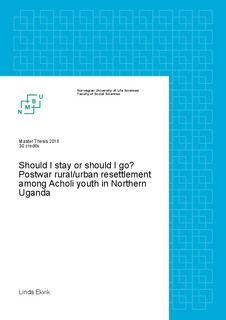| dc.description.abstract | This research is an empirical study of postwar rural-urban migration among Acholi youth in Northern Uganda. In this thesis I look at the connection between rural land access among Acholi youth and their urban-rural social resettlement after the ceasefire between The Lord’s Resistance Army (LRA) and the Ugandan People’s Defence Force (UPDF), from the theoretical framework of Everett S. Lee’s (1966) push and pull factors in migration. The social resettlement of Acholi youth after the war is seen in the light of their current rural land access.
During my fieldtrip to Northern Uganda I interviewed 13 Acholi youths in rural, semi-urban and urban areas and four expert informants. According to perceptions of informants in this study, the majority of Acholi youth have not resettled in a rural place in spite of their regained rural land access. Hence, there seems to be a weak correlation between youths’ rural land access and their rural resettlement. This can be connected to what youth informants of this study perceive to be urban advantages or urban pull factors, like urban educational and economic opportunities, which enable a more diverse lifestyle than found in rural places. Urban and semi-urban environments of displacement during the war can have played a role in enhancing the awareness among Acholi youth of urban advantages.
The study also suggests that postwar rural land access combined with postwar urban youth centralization have created blurred lines between rural and urban Acholi youth. For instance, for youth informants who now have their basic homestead in an urban place, it was not uncommon to be connected to rural land through part time rural agricultural activities. Additionally, many youth was reported to have resettled in rural places after the closure of the IDP camps even though some would prefer urban resettlement. Youth who are settled in urban places can often have parents who have resettled in a rural place. Lastly, several youth informants expressed a feeling of belonging to their rural customary land, as their place of origin, even though they have resettled in an urban place. With the lack of a clear urban/rural distinction between Acholi youth, a wave of increasing tendency to privatize land in Northern Uganda and a changing postwar mentality concerning the meaning of land and wealth, Acholi youth seem to have been put in a limbo between changes of modernity and the status quo of tradition embedded in their rural customary land. This was seen in their ambivalence towards having the interest to sell rural customary land, a desire to own their own private land, their longing for an identity based on their roots and origin and the continuity reflected in their rural customary land. | nb_NO |

